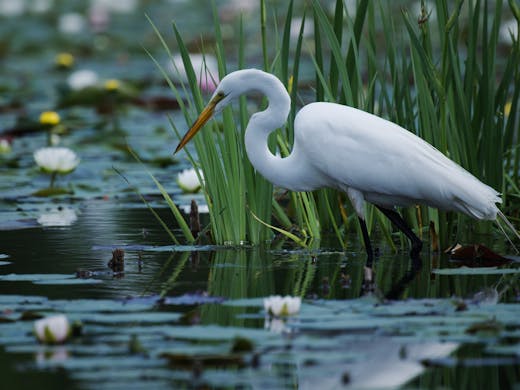Great Egret Ardea alba
A large heron will all-white plumage, yellow bill and black feet. Migratory in Montreal area, heading South late autumn and returning in April. Mainly eats fishes, frogs and small mammals.
Specs
| Length | 90-120cm |
| Weight | 0.9-1.6g |
| Wingspan | 150-180cm |
Common Names
| German | Silberreiher |
| English | Great Egret |
| French | Grande Aigrette |
| Spanish | Garceta grande |
Taxonomy
| Order | Pelecaniformes |
| Family | Ardeidae |
| Species | Ardea alba |
Advertisement
We need your help! By making a contribution towards our hosting costs, you can help us provide an ad-free experience on our website in the near future. Paypal
How to Identify
White plumage is a distinctive characteristic of this species. Together with the yellow color of the bill and the black legs and feet, it allows one to identify this species.
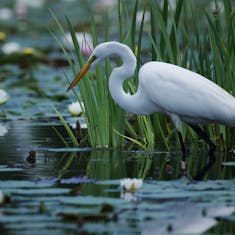
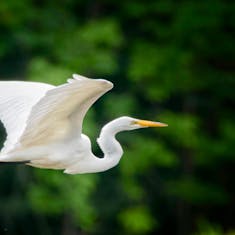
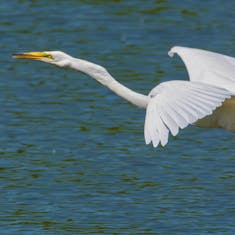
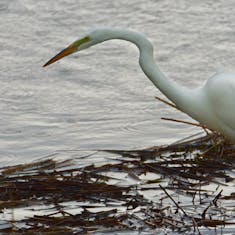
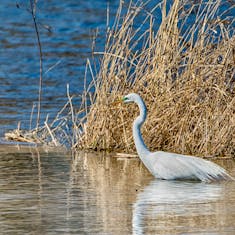
Great Egret Trivia
Is the Great Egret an endangered species?
No, not anymore. The Great Egret was on the brink of extinction over 100 years ago due to hunting for its ornamental feathers. However, the species has made a significant recovery due to conservation efforts, including legal protection.
Is the Great Egret the largest heron in North America?
No, it is not. The Great Egret is the second largest, standing up to 1 meter tall. The distinction of being the largest heron species in North America belongs to the Great Blue Heron, which can reach a height up to 140 cm.
Is the Great Egret a carnivore?
Yes, the Great Egret is primarily a carnivore. Its diet consists mainly of fish, amphibians, small reptiles, insects, and other small aquatic creatures that it catches with its long, sharp bill while wading along or standing still at the shores of ponds and rivers.
Does the Great Egret hunt alone?
Yes, the Great Egret is known for its solitary hunting behavior, where it carefully searches for prey in shallow waters, relying on its rapid strike and sharp bill to capture fish and other small aquatic animals.
Does the color of the Great Egret change during the breeding season?
Yes, although their overall white plumage remains unchanged, Great Egrets develop long, ornamental plumes, vibrant facial skin colors, and brighter leg colors for courtship displays and to establish dominance among rivals.
Great Egrets can be found on every continent?
Yes, although native to North America, this species has established populations on all continents except Antarctica. There are regional variations in plumage and size, but they are all recognized as one globally distributed species.
Does the Great Egret exhibit sexual dimorphism?
Yes, sexual dimorphism is observed in Great Egrets, with males typically larger than females on average. During the breeding season, males also develop longer ornate plumes and more colorful facial skin.
Does the Great Egret have black legs and feet?
Yes, that is correct. The black color of its legs and feet, along with its yellow bill, helps distinguish this species from other white egrets such as Snowy Egret or Cattle Egret. However, the color may become more vibrant during the breeding season.
Is the Great Egret the fastest flying Heron in Eastern Canada?
Yes. Despite their size and elegance, Great Egrets can reach impressive speeds up to 56 km/h while the Great Blue Heron and the Green Heron can fly up to 48km/h and the Black-crowned Night Heron up to 40 km/h.
Is the Great Egret a migratory bird?
Yes, the Great Egret is known for its seasonal migrations, traveling from its northern breeding areas to southern locations where it stays during the winter months. However, there are sedentary populations in more temperate or tropical regions that do not migrate.
Is the Great Egret a vocal bird?
No, the Great Egret is generally quiet and does not produce a wide range of vocalizations. Instead, it often hunts and moves about silently. However, it may make occasional low, guttural calls during courtship and nesting activities.
Does the Great Egret possess physical adaptations for wetlands?
Yes, the Great Egret possesses several physical adaptations that make it well-suited for wetland environments. These adaptations include long legs for wading through shallow water, a long neck for striking at prey, and specialized feet with long toes for walking on aquatic vegetation without sinking.
Where and When to Spot
From April to October along rivers, lakes and ponds. More rare than the Great Blue Heron with whom it shares the feeding habitat.
| Spring | Summer | Fall | Winter | |
|---|---|---|---|---|
| Jardin Botanique de Montréal | x | - | - | - |
| Parc Angrignon | - | x | - | - |
| Parc de la Frayère | - | x | - | - |
| Parc des Rapides | - | x | - | - |
Where and when a species has been observed, identified, and recorded.
